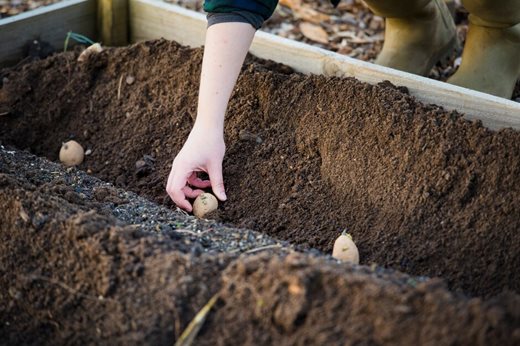April is the time to be engrossed in the veg plot says Chief Horticulturist, Guy Barter, who offers up time-saving ‘hacks’ for the busy gardener

April is such a busy time for the vegetable grower. Removing spent winter crops, weeding, preparing seedbeds, sowing, planting potatoes and onion sets, thinning early crops and hoeing are all work in progress just now. But can anything be done to ease the workload?
Take the work out of weeding
If you're planning to grow cabbage family crops for next winter, or tender summer crops such as courgettes and sweetcorn, you'll have bare areas of ground that aren't due to be planted for another six weeks or so.
To stop weeds in their tracks cover these areas with a smothering layer of rotted manure or compost or a black plastic sheet. It's frowned upon now to mulch earth with old carpet due to its potential as a source of microplastic pollution as well as the hazards of pollution from glue, but black woven polypropylene sheets can be used, last for years and have many garden uses. I have sheets that are more than 20 years old.
 To dig or not to dig?
To dig or not to dig?
Turning over the ground once winter crops are removed is slow, hard work. A rotovator is useful in emergencies – but, just like digging, rotovating can lose valuable soil moisture. Consider loosening compacted earth by inserting a fork and slightly levering the ground, then hoe shallowly to make a seedbed.
Strip cultivation saves time and effort for widely-spaced crops such as potatoes, pumpkins, courgettes, sweet potatoes and squashes – simply till a 20cm strip with hoe or mattock, mixing in fertiliser as you go. The area between the planted strips is simply hoed free of weeds, as required.
If your soil is free of root diseases such as clubroot of brassicas and white rot of alliums, consider raising plants in seedbeds. Till a modest area of fertile ground and sow brassicas, purple sprouting broccoli, autumn cauliflowers and leeks, if you like. Cover with cloches or fleece to fend off pests and boost growth. The young plants will be ready to move to their final positions in summer, when you’ve had more time to prepare the ground in readiness. You could raise your plants in cell trays (modules) – but a seedbed requires less watering and feeding, although weeding is important.
 Sowing success
Sowing success
Thinning seedlings can be slow and tedious. Avoid this by ‘station sowing’ – sow three to five seeds where you intend each plant to eventually grow, so only a few seedlings are surplus to requirements.
Raising transplants is one of the most enjoyable, rewarding and money-saving parts of growing vegetables, but if you run out of time, good plants are widely offered in nurseries and garden centres.
 Pick of the crop
Pick of the crop
Look for the RHS Award of Garden Merit (AGM) when buying vegetable seed or small plants. You can also download the RHS lists of recommended cultivars.
See also

